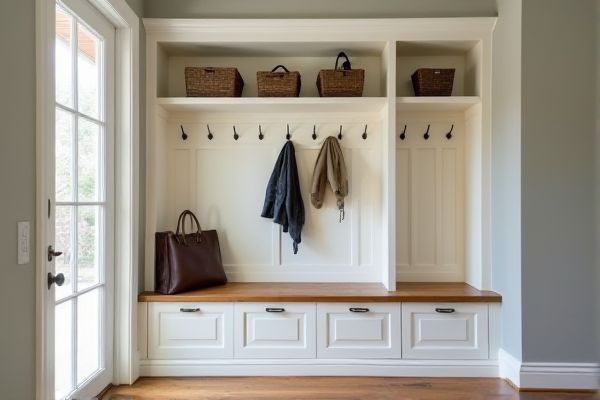
Mudroom lockers provide organized, enclosed storage ideal for keeping your belongings tidy and protected, while open hooks offer quick and easy access for frequently used items but may lead to clutter. Discover which option best suits your home's needs and enhances your mudroom's functionality by reading the rest of this article.
Table of Comparison
| Feature | Mudroom Locker | Open Hooks |
|---|---|---|
| Storage Type | Enclosed compartments with shelves | Simple hooks on wall |
| Organization | High - separate sections for each user | Low - limited to hanging items |
| Security & Privacy | Locked or enclosed for privacy | Open and visible to all |
| Space Efficiency | Bulkier, requires more wall space | Minimal, ideal for small spaces |
| Maintenance | Easier to keep clean and organized | May appear cluttered easily |
| Cost | Higher initial investment | Low cost and easy to install |
| Aesthetic | Structured, built-in look | Casual, open design |
| Best Use Case | Families, high storage needs | Small spaces, minimal storage |
Introduction: Mudroom Locker vs Open Hooks
Mudroom lockers provide organized, enclosed storage compartments ideal for keeping personal items secure and clutter-free, while open hooks offer quick and easy access for hanging coats and bags. Your choice depends on the need for privacy and tidiness versus convenience and visibility. Both options enhance entryway functionality but cater to different storage preferences and space aesthetics.
Design Aesthetics: Sleek Lockers vs Minimalist Hooks
Mudroom lockers offer a sleek, organized appearance that conceals clutter and integrates seamlessly with modern interior design, enhancing your home's overall aesthetics. Open hooks provide a minimalist, airy feel that emphasizes simplicity and accessibility, perfect for casual or small spaces. Choosing between lockers and hooks depends on whether you prioritize concealed storage or an open, streamlined look.
Storage Capacity: Maximizing Space Efficiency
Mudroom lockers offer significantly higher storage capacity by combining enclosed compartments, shelves, and cubbies, allowing for organized storage of shoes, coats, and personal items in one compact unit. Open hooks provide limited space primarily for hanging coats or bags but lack the ability to store smaller items or keep clutter contained. Choosing mudroom lockers maximizes space efficiency by utilizing vertical and hidden storage, reducing visual clutter and maintaining a tidy entryway.
Organization and Clutter Control
Mudroom lockers provide enclosed storage compartments that effectively contain shoes, bags, and outerwear, minimizing visible clutter and enhancing overall organization. Open hooks offer quick access and convenience for hanging coats and hats but often result in a visually cluttered space due to items being exposed. For superior clutter control and maintaining a tidy mudroom, lockers with dedicated cubbies and shelves outperform open hooks by keeping belongings neatly concealed and organized.
Accessibility: Convenience for Daily Use
Mudroom lockers provide organized compartments that enhance accessibility by keeping your belongings neatly stored and easily reachable, reducing clutter during daily routines. Open hooks offer quick grab-and-go convenience for frequently used items like coats and bags but may create visual disorder if overcrowded. For optimal daily use, lockers ensure a tidy space that accommodates diverse storage needs, while open hooks excel in immediate accessibility.
Customization Options and Flexibility
Mudroom lockers offer extensive customization options with built-in compartments, shelves, and cubbies tailored to specific storage needs, enhancing organization and maximizing space efficiency. Open hooks provide flexible, easily accessible storage with minimal installation, ideal for quick changes and versatile use but lack enclosed storage capabilities. Choosing between lockers and open hooks depends on prioritizing personalized, organized storage versus simple, adaptable hanging space.
Durability and Maintenance
Mudroom lockers offer superior durability with enclosed compartments made from solid wood or metal, protecting belongings from dust and damage, while open hooks are prone to wear and may scratch walls over time. Lockers require minimal maintenance, often limited to occasional cleaning and tightening hardware, whereas open hooks need frequent wall inspections and cleaning due to exposed items collecting dust. Choosing mudroom lockers enhances long-term durability and reduces upkeep, making them ideal for busy households seeking organized, low-maintenance storage solutions.
Safety Considerations for Families
Mudroom lockers provide enhanced safety for families by securely storing coats, shoes, and backpacks, reducing trip hazards and keeping sharp objects out of children's reach. Open hooks can lead to clutter and items falling, increasing the risk of accidents and injuries in high-traffic areas. Your family's safety benefits from the organized and enclosed design of lockers, which helps maintain a tidy, hazard-free entryway.
Cost Comparison: Budget and Investment
Mudroom lockers typically involve a higher upfront investment due to their enclosed design, durable materials, and additional storage features, making them a more budget-intensive option. Open hooks offer a cost-effective alternative with minimal installation expenses and simpler materials, ideal for households seeking functionality without significant financial commitment. Evaluating long-term durability and organizational needs helps determine whether the higher price of lockers justifies the budget compared to the straightforward, economical setup of open hooks.
Choosing the Best Solution for Your Home
Mudroom lockers offer organized, enclosed storage compartments that help keep belongings tidy and hidden from view, making them ideal for families seeking a clutter-free space. Open hooks provide quick, accessible hanging options suitable for smaller mudrooms or homes prioritizing ease of use and airflow. Selecting the best solution depends on available space, storage needs, and aesthetic preferences to create a functional and welcoming entryway.
 homyna.com
homyna.com